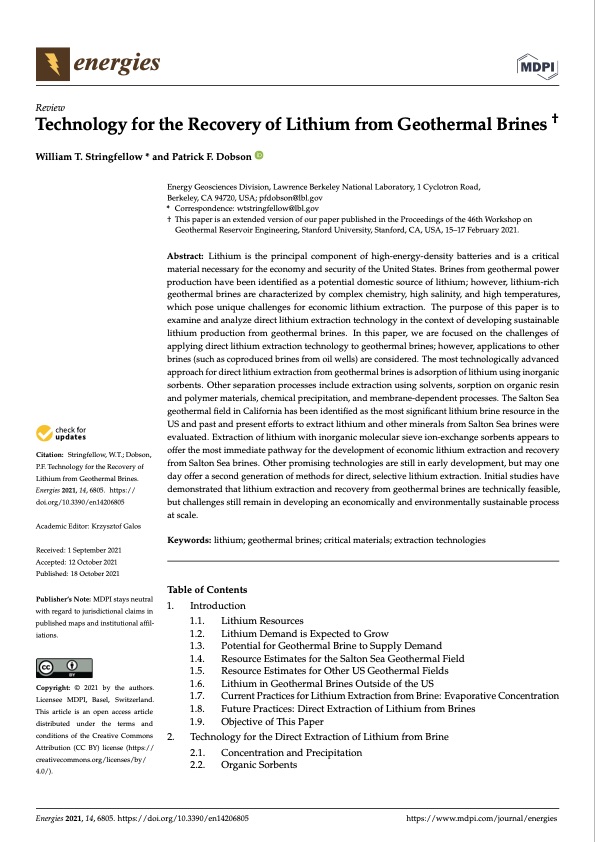
PDF Publication Title:
Text from PDF Page: 001
energies Review Technology for the Recovery of Lithium from Geothermal Brines † William T. Stringfellow * and Patrick F. Dobson Citation: Stringfellow,W.T.;Dobson, P.F. Technology for the Recovery of Lithium from Geothermal Brines. Energies2021,14,6805. https:// doi.org/10.3390/en14206805 Academic Editor: Krzysztof Galos Received: 1 September 2021 Accepted: 12 October 2021 Published: 18 October 2021 Publisher’s Note: MDPI stays neutral with regard to jurisdictional claims in published maps and institutional affil- iations. Copyright: © 2021 by the authors. Licensee MDPI, Basel, Switzerland. This article is an open access article distributed under the terms and conditions of the Creative Commons Attribution (CC BY) license (https:// creativecommons.org/licenses/by/ 4.0/). Energy Geosciences Division, Lawrence Berkeley National Laboratory, 1 Cyclotron Road, Berkeley, CA 94720, USA; pfdobson@lbl.gov * Correspondence: wtstringfellow@lbl.gov † This paper is an extended version of our paper published in the Proceedings of the 46th Workshop on Geothermal Reservoir Engineering, Stanford University, Stanford, CA, USA, 15–17 February 2021. Abstract: Lithium is the principal component of high-energy-density batteries and is a critical material necessary for the economy and security of the United States. Brines from geothermal power production have been identified as a potential domestic source of lithium; however, lithium-rich geothermal brines are characterized by complex chemistry, high salinity, and high temperatures, which pose unique challenges for economic lithium extraction. The purpose of this paper is to examine and analyze direct lithium extraction technology in the context of developing sustainable lithium production from geothermal brines. In this paper, we are focused on the challenges of applying direct lithium extraction technology to geothermal brines; however, applications to other brines (such as coproduced brines from oil wells) are considered. The most technologically advanced approach for direct lithium extraction from geothermal brines is adsorption of lithium using inorganic sorbents. Other separation processes include extraction using solvents, sorption on organic resin and polymer materials, chemical precipitation, and membrane-dependent processes. The Salton Sea geothermal field in California has been identified as the most significant lithium brine resource in the US and past and present efforts to extract lithium and other minerals from Salton Sea brines were evaluated. Extraction of lithium with inorganic molecular sieve ion-exchange sorbents appears to offer the most immediate pathway for the development of economic lithium extraction and recovery from Salton Sea brines. Other promising technologies are still in early development, but may one day offer a second generation of methods for direct, selective lithium extraction. Initial studies have demonstrated that lithium extraction and recovery from geothermal brines are technically feasible, but challenges still remain in developing an economically and environmentally sustainable process at scale. Keywords: lithium; geothermal brines; critical materials; extraction technologies Table of Contents 1. Introduction 1.1. Lithium Resources 1.2. Lithium Demand is Expected to Grow 1.3. Potential for Geothermal Brine to Supply Demand 1.4. Resource Estimates for the Salton Sea Geothermal Field 1.5. Resource Estimates for Other US Geothermal Fields 1.6. Lithium in Geothermal Brines Outside of the US 1.7. Current Practices for Lithium Extraction from Brine: Evaporative Concentration 1.8. Future Practices: Direct Extraction of Lithium from Brines 1.9. Objective of This Paper 2. Technology for the Direct Extraction of Lithium from Brine 2.1. Concentration and Precipitation 2.2. Organic Sorbents Energies 2021, 14, 6805. https://doi.org/10.3390/en14206805 https://www.mdpi.com/journal/energiesPDF Image | Recovery of Lithium from Geothermal Brines

PDF Search Title:
Recovery of Lithium from Geothermal BrinesOriginal File Name Searched:
energies-14-06805-v2.pdfDIY PDF Search: Google It | Yahoo | Bing
Product and Development Focus for Infinity Turbine
ORC Waste Heat Turbine and ORC System Build Plans: All turbine plans are $10,000 each. This allows you to build a system and then consider licensing for production after you have completed and tested a unit.Redox Flow Battery Technology: With the advent of the new USA tax credits for producing and selling batteries ($35/kW) we are focussing on a simple flow battery using shipping containers as the modular electrolyte storage units with tax credits up to $140,000 per system. Our main focus is on the salt battery. This battery can be used for both thermal and electrical storage applications. We call it the Cogeneration Battery or Cogen Battery. One project is converting salt (brine) based water conditioners to simultaneously produce power. In addition, there are many opportunities to extract Lithium from brine (salt lakes, groundwater, and producer water).Salt water or brine are huge sources for lithium. Most of the worlds lithium is acquired from a brine source. It's even in seawater in a low concentration. Brine is also a byproduct of huge powerplants, which can now use that as an electrolyte and a huge flow battery (which allows storage at the source).We welcome any business and equipment inquiries, as well as licensing our turbines for manufacturing.| CONTACT TEL: 608-238-6001 Email: greg@infinityturbine.com | RSS | AMP |